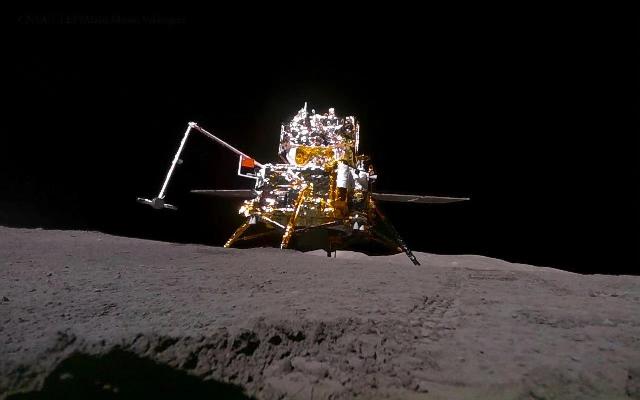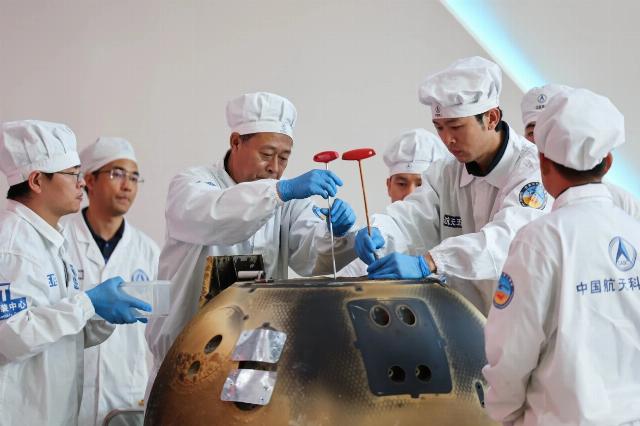Celebrations on the occasion of the delivery of soil from the Moon by the Chang'e-6 station continue . The Chinese managed to complete the most difficult lunar mission in the history of space automata. After landing on June 25, the return vehicle was transported to Beijing, where the container with the first samples from the far side of the Moon was retrieved the next day. The mass of the collected samples (1935.3 grams) was announced only on June 28. It turned out to be larger than the delivered Chang'e-5. However, according to the statement of the flight managers led by Hu Hao, the drill could not reach a depth of 2.5 meters and barely overcame the meter mark, obviously due to the fact that it came across a too hard layer of rock.
Lunar soil "does not let through" drilling rigs
When the Chang 'e-5 drill did not pass even one meter due to similar problems, experts made sure that the Chang'e-6 drill could reach the maximum depth. The fact that this did not happen is probably due to incorrect assumptions about the behavior of the lunar soil and the complexity of modeling its mechanics on Earth (different gravity, adhesion and pressure). On the other hand, the container with samples of regolith and surface rocks collected by the manipulator was filled, unlike Chang 'e-5.
But despite the drilling problems, 1.9 kg is a lot for an automatic mission, which is why China already has 3.6 kg of samples from the moon. Of course, this is far from the 382 kg of stones that the six Apollo missions brought, but much more than the 300 grams that the Soviet probes Luna 16, Luna 20 and Luna 24 brought. The American OSIRIS-REx station brought only 121.6 grams from the asteroid Bennu, and the Japanese probe Hayabusa-2 collected 5.4 grams from the asteroid Ryugu.
The Golden Toad takes a selfie
During these weeks, observers learned that the small rover with a camera, which Chang 'e-6 used as a selfie stick on the surface of the Moon, had the name "Jinchang" (Jin蟾), "golden toad" in Mandarin, a three-legged animal from Chinese mythology associated with luck and the Moon. The 5 kg lunar rover had cameras on both sides and could communicate with Chang 'e-6 via Wi-Fi, similar to the disposable camera left by the Mars rover Zhuzhong.
 |
| Chang'e-6. |
| Source: prokosmos.ru |
Another interesting detail, which became known after the completion of the flight, is that Chang'e-6 was programmed to automatically perform operations in case of loss of communication with the Qiuqiao-2 relay satellite. Fortunately, he did not take advantage of this opportunity in practice, and the sample collection operations, which lasted two days, were supervised from Earth: the team recreated a model of the surface around the probe in order to plan manipulator operations in advance before sending instructions to the station. Jinchang was also programmed to operate autonomously in the event of a communication failure with Earth.
The take-off stage was smashed against the moon
The Chang'e-6 landing stage, like the Chang'e-5, was not calculated for the effect of exhaust gases from the engine of the take-off stage at its launch. Therefore, the mission had to be completed earlier, including the operation of the European instruments on the device. Earlier, some Chinese media said that the systems would continue to function after the completion of the take-off stage and until the moonlit night.
It is known that the Swedish NILS instrument was the first to detect negative ions on the surface of the Moon after three hours of operation (in addition, it became the first ESA instrument operating on our natural satellite). The French DORN has successfully completed its task of detecting radon and other radioactive isotopes. The device was switched on for the first time on May 6 on its way to the Moon, and then for the second time on May 17 already in lunar orbit, where it worked for a total of 32 hours for calibration. On May 23, he was turned on for the third time and worked 111 hours. After landing on the Moon on June 1, the device completed work on the lunar surface and was deactivated before the launch of the take-off stage.
As for the take-off stage, it was deliberately smashed against the lunar surface on June 8, about two days after docking with the orbital module and transferring the sample container to the return vehicle. The crash site, oddly enough, is located on the invisible side of the Moon, not far from the Chang'e-4 landing zone (recall that Chang'e-6 was placed into a retrograde orbit, unlike previous Chinese lunar vehicles).
Unlike the last two expeditions, they will include two orbiters that will analyze the Moon using numerous instruments of all types (since Chang 'e-2 left lunar orbit in June 2011, China does not have an orbiter for scientific research). In addition, the two probes include landers that will land at the south pole and will carry rovers and jump jumpers capable of directly exploring permanently shadowed craters. But before the launch of Chang'e-7, China will launch a device next year to return samples from the Tianwen-2 asteroid.
There is no race, but the tension is growing
As for the Chang'e-6 samples, the process of their analysis has already begun, which will last several years. China has already announced its intention to share samples with other countries with which it maintains relations in the space sector. NASA Administrator Bill Nelson immediately expressed his interest in this proposal, although it is unknown whether the US Congress will allow such cooperation.
"I have made it very clear that we are in a space race with China, and they are very good," Nelson said in a recent interview with the Washington Post, "They have achieved a lot, especially in the last 10 years, and usually do what they say."
He mentioned that although China has achieved a lot in the field of space, including the construction of an orbital station and the landing of a rover on Mars in 2021, the United States is still ahead of its main competitors in the manned moon landing project.
Nelson mentioned the latest successful test of the Starship system by the American company Space X as a "good indicator" of how NASA is able to get ahead of China in sending astronauts to the Moon. But the Washington Post mentioned that to do this, the "Spaceship" must be refueled in low-Earth orbit. This plan is ambitious and complex, and it may take years to implement.
Nelson said that despite the competition between the United States and China, the two countries must find a way to coexist on and around the moon.
According to Chinese experts, in recent years, the United States has continued to fabricate and implement the "Chinese space threat", while accelerating the militarization of space. A representative of the Ministry of National Defense of the People's Republic of China once replied that China insists on the peaceful use of outer space, strongly opposing the deployment of weapons in space and the conduct of hostilities there, as well as against any form of a space arms race. This position has not changed and will not change.
It is worth noting that although American politicians, including Nelson, seek to spin the top of the "space race between China and the United States," astronauts participating in the American Artemis manned moon landing program do not think so. Astronaut Reed Wiseman recently told the Washington Post: "We don't think it's a race. We just feel that this is the right direction of research and that we are moving forward on it," and then added, "But as an American, I really feel the tension growing."
On June 25, the day Chang 'e-6 returned, CNN reported that the Chinese spacecraft had brought "treasures from afar," and scientists from China and around the world have high hopes for the information contained in the samples. "This is a gold mine… A treasure trove! – says James Hyde, professor of planetary Earth sciences at American Brown University. "Scientists around the world are very excited about the mission." Planetary scientist Brad Joliffe of Washington University in St. Louis sighed that the Chang'e-6 mission was "impressive" and "it worked like clockwork." According to Namrata Goswami, a writer and space policy expert at Arizona State University, the success of Chang 'e-6 means that "China has mastered and improved the technology of entering lunar orbit, landing, autonomous sample collection and return."
Igor Afanasyev

